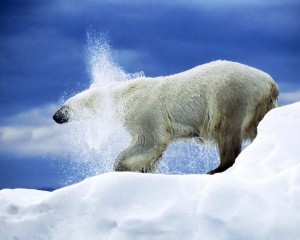Polar Bears are Clean Freaks?
Polar bears (Ursus maritimus) spend a great deal of their time grooming their coat throughout the day. After feeding, they make sure they remove all blood and fat that had contaminated their fur coat by swimming, grooming and rolling on fresh snow. So, why are polar bears so “vain”?
Importance of The “White” Coat
This “white” colour we see is due to the lack of pigmentation within the hair shaft. Imagine each hair as a hollow tube. Under light, the hairs collectively scatter and reflect light and thus produce a “white” colour (Rich & Rouse, 2006). These hollow hair can trap air inside, making the bear buoyant in water. It also prevents direct contact of the skin with the Arctic cold water when the bear is swimming.
Drying up After a Swim
Wet fur can reduce its insulation property by 90% (Derocher, 2012). Upon emergence from the water, polar bears shake and roll in snow. This not only removes water, but also helps to re-trap air in their fur.
Cleaning up After Eating
After 20-30 minutes of feeding, polar bears station next to a pool of water to rinse and lick the paws and face for 5-10 minutes before they resume their meal (Kolenosky,1987).
The fur is kept clean to ensure maximum efficiency of the insulating and waterproofing qualities. Hypothermia and even death may sometimes result from the negligence of proper grooming for their coat.
Ingesting Pollutants
During the grooming process, polar bears is not only in contact with natural contaminants but also man-made pollution. Polar bears can die of kidney, lung, liver or brain damage from ingesting crude oil (Ricki & Nils, 1982). As polar bears are at the top of the food web, they are further exposed to pollution through contaminated food sources.
This frequent grooming habit of the polar bears is not just for vanity but survival’s sake. But as we read about the consequences of ingesting pollutants, will this grooming habit bring about short-term benefits of warmth but long-term repercussions on its health?
Bibliography
Derocher, A. E., 2012. Polar Bears: A Complete Guide to Their Biology and Behaviour.
The Johns Hopkins University Press, Baltimore. Pp. 264.
Kolenosky, G.B., 1987. Polar Bear. In: Novak, M., Baker, J.A., Obbard, M.E. & Malloch,
B. (eds.), Wild Furbearer Management and Conservation in North America. Ontario Trappers Association, Toronto. Pp. 474-485.
Rich, T. & A. Rouse, 2006. Distinguishing Features. In: Wildlife Monographs – Polar
Bears. Evans Mitchell Books, Thailand. Pp. 17-31.
Ricki J. H., Nils A. O., 1982. Polar Bear Thermoregulation: Effect of Oil on The
Insulative Properties of Fur. Journal of Thermal Biology, 7(4):201-208.
“Snow Animals Polar Bears”. A-GC.com.
URL: http://www.a-gc.com/images/2012/12/snow-animals-polar-bears-HD-Wallpapers.jpg (accessed on 6 April 2013).
